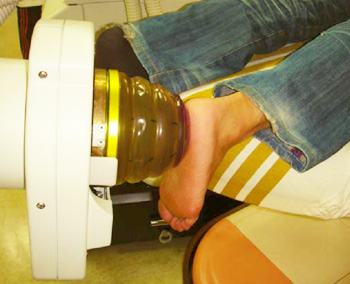Self-Paid Services
As mentioned in the About Us section, most of the rehabilitation treatment services in our department are covered by the National Health Insurance of Taiwan. However, some services are not covered by the National Health. Here, we will describe in detail what self-paid services are provided by the Department of Physical Medicine and Rehabilitation.
Ultrasound-guided Aspiration and Injection Treatments of Musculoskeletal Disorders
Soft tissue (musculoskeletal) disorders such as tendon and muscle strain, muscle tear, bursitis, hematoma, and fluid accumulation within the soft tissue, are common problems often observed in a clinical setting. Even with careful physical examination, these disorders are often difficult to be diagnosed correctly. Sometimes expensive imaging tools such as magnetic resonance imaging (MRI) may be needed to accurately diagnose these soft tissue problems. The treatment of these disorders often involves the insertion of needles for injection and aspiration. This is often done using the blind technique. As a result, there is a high possibility that the needles may fail to reach the lesion sites.
Soft tissue ultrasound is a safe imaging diagnostic tool without radioactivity. It can be used to diagnose soft tissue disorders and as a guidance tool to accurately perform injection and aspiration procedures. The department of physical medicine and rehabilitation medicine in Chang Gung Memorial Hospital has many years of clinical experience in using soft tissue ultrasound in diagnosing and treating soft tissue disorders. Soft tissue ultrasound can guide the injection needle accurately into the target lesion site and deliver the injectant to achieve maximal treatment effect. It is also used to guide the needles accurately into the target sites of hematoma and fluid accumulation to perform successful aspiration procedures. The self-paid cost of receiving ultrasound-guided treatment is 2,500 Taiwan Dollar (NTD) per treatment spot.
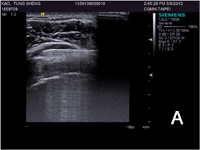
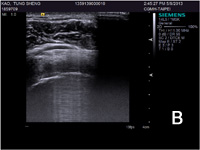
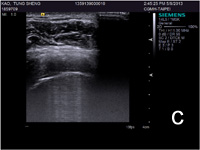
Figures from A to C, a 50 year-old male patient was diagnosed with left shoulder subdeltoid bursitis. The needle was guided accurately into the bursa for successful fluid aspiration.
Ultrasound-guided Caudal Epidural Injection
Low back pain is the chief complaint that is often heard in an outpatient clinic. In fact, the occurrence rate of low back pain is high, similar to the occurrence rate of common cold. The department of physical medicine and rehabilitation medicine in Chang Gung Memorial Hospital has successfully applied soft tissue ultrasound in performing ultrasound guided spinal injection for the treatment of low back pain. The ultrasound guided caudal epidural injection technique we have developed has been published in renowned medical journals. Herniated intervertebral discs and spinal stenosis are the possible causes of low back pain. It is important to find the real cause of low back pain before an optimal treatment option can be chosen. The treatment of low back pain includes oral medications, local injections, physical therapy, and surgery.
During the past decade, the application of spinal injection for the treatment of low back pain has gained wide popularity. For patients not wishing to receive surgical treatment, spinal injection is a feasible alternative treatment option. Treatment options of spinal injection include selective nerve root block, and caudal epidural injection etc… In order for spinal injection to be performed successfully, fluoroscopic guidance is frequently needed, and the injection procedure needs to be performed in the surgery room. This is often tedious, and patients may find it inconvenient to receive such injection treatment.
Caudal epidural injection is effective in treating low back pain caused by lumbar stenosis syndrome and lumbosacral intervertebral disc herniations. Reports have shown that higher lumbar intervertebral disc herniation levels may also benefit from caudal epidural injections. There is a high failure rate when caudal epidural injection is performed blindly. Fluoroscopic guidance can ensure 100% successful rate in performing caudal epidural injection. However, fluoroscopic machine is heavy, and requires tedious multi-angle adjustments during the injection process. Patients will also be susceptible to radiation exposures. Our department has successfully applied soft tissue ultrasound in performing caudal epidural injections. Soft tissue ultrasound can accurately guide the needle into the sacral hiatus to perform successful caudal epidural injection treatments. More conveniently, soft tissue ultrasound guided caudal epidural injection treatment can be performed in an outpatient setting. Thirty minutes of rest is needed before patients can leave the hospital.
The self-paid cost of receiving ultrasound-guided caudal epidural injection is NTD 6,000.
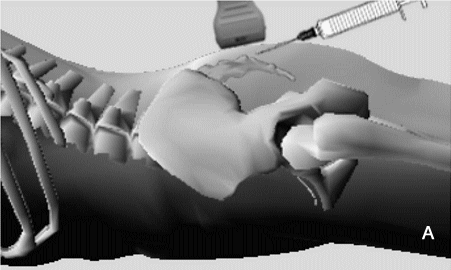
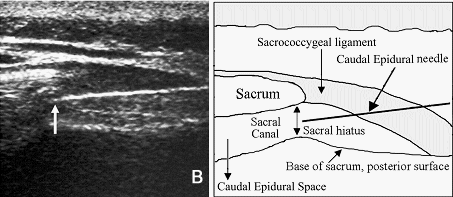
Figures showing how caudal epidural injection is performed. A. During caudal epidural injection, patient assumes the prone position. B. Soft tissue ultrasound can guide the needle into the sacral hiatus to perform successful caudal epidural injection treatments.
Ultrasound-guided Botulinum Toxin Injection
Although botulinum toxin is often applied for cosmetic purposes, it is effective for the treatment of spasticity in stroke patients and patients with central nervous system injuries. Conventionally, botulinum toxin is injected using the nerve stimulator guidance. In our department, we have successfully used the combination of ultrasound and nerve stimulator in guiding the needle accurately into the designated muscles for botulinum toxin injection. This method can increase the success rate of botulinum toxin injection and improve the outcome of spasticity treatment. Recently, it has been documented that botulinum toxin can be used in trigger point injection for effective treatment of myofascial pain syndrome. The self-paid cost of receiving nerve and ultrasound-guided botulinum toxin injection is NTD 2,000 per injection spot.
Extracorporeal Shockwave Treatment in Rehabilitation Medicine
Extracorporeal shockwave is a non-invasive, and non-radioactive treatment method that does not require medication, anesthesia, and surgical intervention. Extracorporeal shockwave treatment is effective in treating musculoskeletal disorders such as tendinitis and chronic myofascial pain syndrome. It is also effective in treating disorders such as calcified tendinitis and mal-healing of the bones. The mechanism of extracorporeal shockwave treatment is similar to the shockwave machine that is used to treat urolithiasis. High energy shockwave is generated, and then transferred to the chronically inflamed or calcified musculoskeletal structures. This will stimulate neovascularization, regeneration, and repair of tissues, resulting in the alleviation of pain and improved life quality. The department of physical medicine and rehabilitation at Chang Gung Memorial Hospital has successfully applied extracorporeal shockwave in treating patients with myofascial pain syndrome and calcified tendinitis. Activities of daily living will not be affected after the treatment. The process of neovascularization and tissue regeneration takes approximately one month. The self-paid cost of receiving shockwave therapy is NTD 15,000 per treatment.
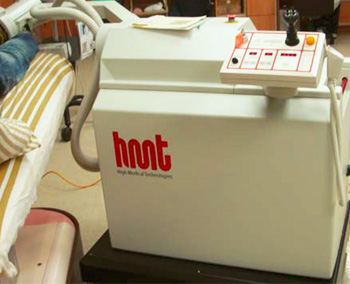
The extracorporeal shockwave machine.
